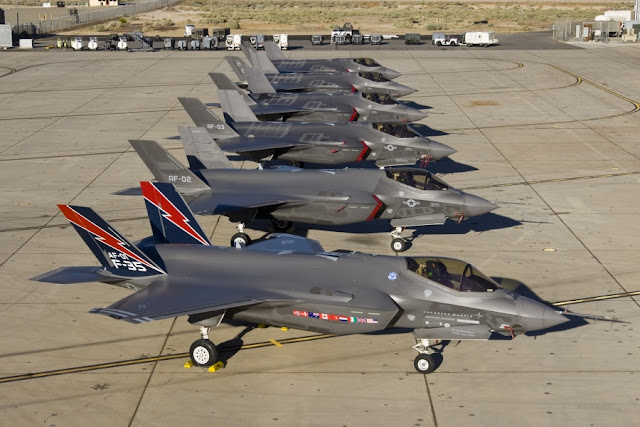F-35 ZOMBIE SHUFFLE: FLEET SIZE "UNDER REVIEW".
 |
| "That's enough?" |
It would seem as though the summer is a very unlucky time for the Joint Strike Fighter.
Last summer, the F-35 weathered some stormy PR after spontaneously combusting during take off. This would have been bad enough by itself, but the incident caused the JSF to be a no-show at its international debut.
This summer, Lockheed Martin and Joint Program Office are mobilizing their PR departments once again after a not-so-complimentary report was leaked detailing the F-35's lack of dogfighting prowess. Some have dismissed the report as "garbage" (yet still slam the JSF for being a "bloated failure"). Whatever the merit of the report, it is still a harsh blow to a program that once boasted of the JSF's superiority compared to fourth-generation fighters.
This latest bit of PR shenanigans may soon be forgotten if this next shoe drops, however...
In a document addressed to the United States of America's Senate Armed Services Committee, (SASC), Marine General Joseph Dunford addressed questions about the F-35's troubles thusly:
[QUESTION:] “Do you believe the nation can afford to procure these aircraft at a cost of $12B to $15B per year for nearly the next 20 years for an aircraft design that will be 30 years old at the completion of the program procurement phase?”
[ANSWER:] “Given the evolving defense strategy and the latest Defense Planning Guidance, we are presently taking the newest strategic foundation and analyzing whether 2,443 aircraft is the correct number."
This could be big.
This could mean that the Pentagon is looking at purchasing more F-35s, but given the context, it seems unlikely. While the U.S. Military seems to have undying patience for the JSF program, the politicians in charge of the pursestrings do not.
Internationally, the Joint Strike Fighter has not quite met the sales expectations envisioned at the start of the program. While some orders have trickled in, most partner nations have drastically cut their intended numbers. Others have decided to "wait and see" while upgrading and extending the life of older fighter inventories. Some, like Canada and Denmark, have "reset" in order to examine other options.
Bottom line: The F-35 will not sell as well internationally as originally hoped. If the USA decides to cut its numbers, there could be trouble for the program. The JSF depends on economies of scale to help bring down unit price. As sales decrease, the unit price increases. As price increases, sales decrease. (etc, etc...) This could lead to the infamous "death spiral".
I have stated before that the "death spiral" is an unlikely scenario. There is too much invested already to deem the aircraft a complete failure and start fresh. Instead, numbers will be drastically cut and the F-35 will become more of a niche aircraft like the B-1B or F-22 instead of next F-16.
Like a proverbial zombie, the JSF program will continue to shuffle along... But rotten chunks of it are starting to fall off.
[For those who haven't read it, you can find my original "Zombie Shuffle" post here]



Comments
Post a Comment